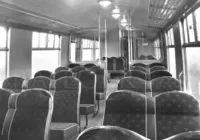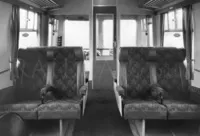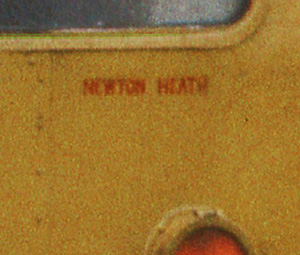Class 105/6 Cravens 2 & 3-car DMUs
Interior
The floor cavity between the underside of the plywood floor panels, and above the longitudinal corrugated floor sections was insulated, and the exterior body panels were sprayed with Limpet asbestos supplied by JW Roberts Ltd. Linoleum covered the floors, as well as carpets (supplied by T. F. Firth & Sons Ltd) in first class.
Interiors were simple with little embellishment, the seating was in the usual 2+3 configuration with curved top bus style seats in second class, with the more comfortable 2+2 seats with arm rests and headrolls in first class.


Originally second class seats (first image) were trimmed with maroon moquette and first class (second image) in blue (the moquette was supplied by John Holdsworth & Co Ltd). All seats had foam rubber fillings (supplied by the Dunlop Rubber Co. Ltd.), and the tubular seat frames were stoved to tone with the trim. The seat frames in first class were supplied by GD Peters & Co. Ltd, and the curved topped ones fitted to second class came from Accles & Pollock Ltd. The Vynide for seat trimming came from ICI Ltd.
Continuous parcel racks of light alloy anodised in self colour ran the full lengths of the saloons. Saloon lighting was the standard silver ringed shades supplied by J. Stone & Co. (Deptford) Ltd. with 60W 24V lamps.
Side panelling in the saloons was finished in shades of Formica, and ceiling panels were painted off-white. Doors were panelled in plastic with wood grain effect and mouldings were of anodised aluminium. All the vehicles plastic veneers were supplied by Thomas De La Rue & Co Ltd (later known as Formica Ltd.). The ceiling panels came from the Edmunston Panel Co. Ltd., and bodyside panels & partitions came from Insulation Equipment Ltd.
British Railway's standard bodyside windows with sliding ventilators were fitted (the vents were supplied by J. Gibbons Ltd & Transport Engineering Equipment Ltd), the glazing of the lower glass was by means of an anodised aluminium moulding incorporating a drain trough. Beclawat full drop balance windows were fitted to the entrance doors.
The toilets had primrose yellow furnishings with matching plastic panels.
Heating
Each car had two Smiths oil-burning heaters, each operating on independent systems. One heated recycled air, the other fresh air from the outside, both used Ozonair filters between air intake and heater. The warmed air was fed through underfloor ducts with headers suitably spaced below the seats.

Cabs
The cabs were plastic lined to match the interior of the adjacent saloon. The drivers desk sloped, which was to the benefit of passengers, as the staff couldn`t put their bags on it and obstruct their view. Windscreen wipers were supplied by Laycock Engineering Co. Ltd. Demisting and defrosting of cab windscreens was by means of a fan and flap valve to blend heated air from the ducting to mix with air from a grille at the front of the cab.
Modifications

Seats would be recovered overed the years, this image shows the interior of 56449 in 1978 with a blue check moquette. Robert Chilton.
As with many DMU composite vehicles, in later years the DTC(L)s were downgraded to DTS(L)s, and some of the TC(L)s became TS(L)s.
53812 was given a test "refurbishment" with the asbestos being removed and the interior upgraded. The lack of asbestos would mean this vehicle would survive longer than the others.
Refurbishment
No other vehicles were asbestos stripped, nor were the vehicle part of the main 1970s 'Refurbishment' programme, but some vehicles were given a mini-refurbishment by depots. This included seven Norwich sets treated by Ipswich C&W Shops in late 1978:[1]
51297 + 56414
51273 + 56188*
51291 + 56467
51269 + 56134
51484 + 56448
51262 + 56451
50596* + 56139
* Class 104 vehicles

Newton Heath would tackle three sets in the early 1980s.[2] The repairs were classified as 'DUG 57' (possibly Diesel Unit Upgrade?) and some Class 104s were also treated. The work typically involved retrimmed seats, new wall panels inside, a general clean-up externally and the Manchester M symbol applied. First done were 50777 + 50802 in October 1980. 50777 would receive red buffer beams, the M on the drivers side. 50802 had both the M and BR arrows on the drivers side. Both had NEWTON HEATH in red on cab ends (seen in the image on 50777).
Next was 50761 + 50794 in December 1980, 50761 had M on the drivers side, 50794 had the M and BR arrows on the drivers side. Both had "NEWTON HEATH" in red on the cab end. They would initially running with Class 104 centre car 59207. The third set was 50765 + 50804 but were not as embellished as the first two sets.
Some other vehicles were selected for the same improvements, but were withdrawn instead, including 50767, 50771 and 50800.
References
Summary
Orders
Description - General
Description - Variations
Description - Interior
Works Photos & Drivers Inst.
Diagrams
Numbering
Liveries
Operations - Batch One
Operations - Batch Two
Operations - Batch Three
Operations - Batch Four
Operations - Scotland
Accidents
Decline
Parcel Use
Other Non-Passenger Use
Images
Details about preserved Class 105s can be found here.


